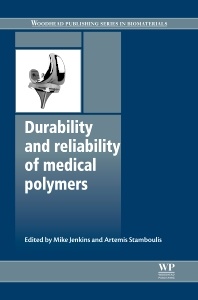Description
Durability and Reliability of Medical Polymers
Woodhead Publishing Series in Biomaterials Series
Coordinators: Jenkins Mike, Stamboulis Artemis
Language: English
Subjects for Durability and Reliability of Medical Polymers:
296 p. · 15.5x23.2 cm · Hardback
Description
/li>Contents
/li>Biography
/li>Comment
/li>
Part one provides a review of the types and properties of bioresorbable medical polymers. The effect of molecular structure on properties is discussed, along with the processing of bioresorbable and other polymers for medical applications. Transport phenomena and the degradation of bioresorbable medical polymers are reviewed, before an exploration of synthetic bioresorbable polymers and their use in orthopaedic tissue regeneration. Part two goes on to explore the durability and reliability of non-bioresorbable medical polymers, and wear processes in polymer implants and ageing processes of biomedical polymers in the body are discussed in depth, before an investigation into manufacturing defects and the failure of synthetic polymeric medical devices.
With its distinguished editors and international team of expert contributors, Durability and reliability of medical polymers is an essential tool for all materials scientists, researchers and engineers involved in the design, development and application of medical polymers, whilst also providing a helpful overview of the subject for biologists, chemist and clinicians.
Contributor contact details
Woodhead Publishing Series in Biomaterials
Part I: Types and properties of bioresorbable medicalpolymers
Chapter 1: Types of bioresorbable polymers for medical applications
Abstract:
1.1 Introduction
1.2 Aliphatic polyesters
1.3 Polyanhydrides
1.4 Poly(ortho esters)
1.5 Polyphosphazenes
1.6 Poly(amino acids) and ‘pseudo’ poly(amino acids)
1.7 Polyalkylcyanoacrylates
1.8 Poly(propylene fumarate) (PPF), poloxamers, poly(p-dioxanone) (PPDO), polyvinyl alcohol (PVA)
Chapter 2: The effect of molecular structure on the properties of biomedical polymers
Abstract:
2.1 Introduction: the molecular structure of polymers
2.2 Molecular weight and polymer properties
2.3 Macromolecular conformation, crystallisation and polymer properties
2.4 The effect of the amorphous state and glass transition temperature on polymer properties
2.5 Biphasic systems: linear crystalline polymers and their properties
Chapter 3: Processing of bioresorbable and other polymers for medical applications
Abstract:
3.1 Introduction
3.2 Extrusion
3.3 Mixing processes
3.4 Molding processes
3.5 Secondary shaping
3.6 Calendering
3.7 Coating
3.8 Foaming
3.9 Solvent casting
3.10 Challenges in biopolymer processing
3.11 Conclusions
Chapter 4: Understanding transport phenomena and degradation of bioresorbable medical polymers
Abstract:
4.1 Introduction to transport phenomena in irreversible processes
4.2 Introduction to mathematical modelling
4.3 Conclusions and future trends
Chapter 5: Synthetic bioresorbable polymers
Abstract:
5.1 Introduction
5.2 Bioresorbable polymers
5.3 Degradation of aliphatic polyesters
5.4 Factors affecting aliphatic polymer degradation
5.5 Processing and devices
5.6 Conclusions
Chapter 6: Using synthetic bioresorbable polymers for orthopedic tissue regeneration
Abstract:
6.1 Introduction
6.2 Poly (α-hydroxy acids)
6.3 Polylactones
6.4 Polyanhydrides
6.5 Fumarate-based polymers
6.6 Hydrogels
6.7 Future trends
6.8 Conclusions
Part II: Aspects of durability and reliability of non-bioresorbable medical polymers
Chapter 7: Wear processes in polymer implants
Abstract:
7.1 Introduction
7.2 Implants
7.3 Wear processes and theory for polymer implants
7.4 Polymers
7.5 Wear debris in the body
7.6 Future trends
7.7 Sources of further information and advice
Chapter 8: Ageing processes of biomedical polymers in the body
Abstract:
8.1 Introduction
8.2 Principles of chemical and biochemical degradation and calcification
8.3 Effect of natural ageing of medical polymers
8.4 Principles of accelerated ageing
8.5 Conclusions and summary
8.6 Sources of further information and advice
8.7 Acknowledgements
Chapter 9: The failure of synthetic polymeric medical devices
Abstract:
9.1 Introduction
9.2 Forensic methods
9.3 Catheter failure
9.4 Balloon catheters and angioplasty
9.5 Breast implants
9.6 Intraocular lenses
9.7 Failure of Foley catheters
9.8 Sutures
9.9 Conclusions
9.10 Acknowledgements
Chapter 10: Manufacturing defects in polymeric medical devices
Abstract:
10.1 Introduction
10.2 Polymer moulding
10.3 Catheter systems
10.4 Security cap for gas cylinders
10.5 Breathing tube failures
10.6 A failed crutch
10.7 Cracked medical tubing
10.8 Conclusions
10.9 Acknowledgements
Index
Artemis Stamboulis is a Senior Lecturer in Biomaterials and Nanomaterials at the University of Birmingham’s School of Metallurgy and Materials. Dr Stamboulis has published over 40 research papers in international scientific journals and is an active member of many national and international societies.
- Comprehensively examines the performance of both bioresorbable and non-bioresorbable medical polymers
- Discusses the processing of bioresorbable and other polymers for medical applications, before reviewing the degradation of bioresorbable medical polymers
- Explores the durability and reliability of non-bioresorbable medical polymers and discusses wear processes in polymer implants and ageing processes of biomedical polymers in the body




